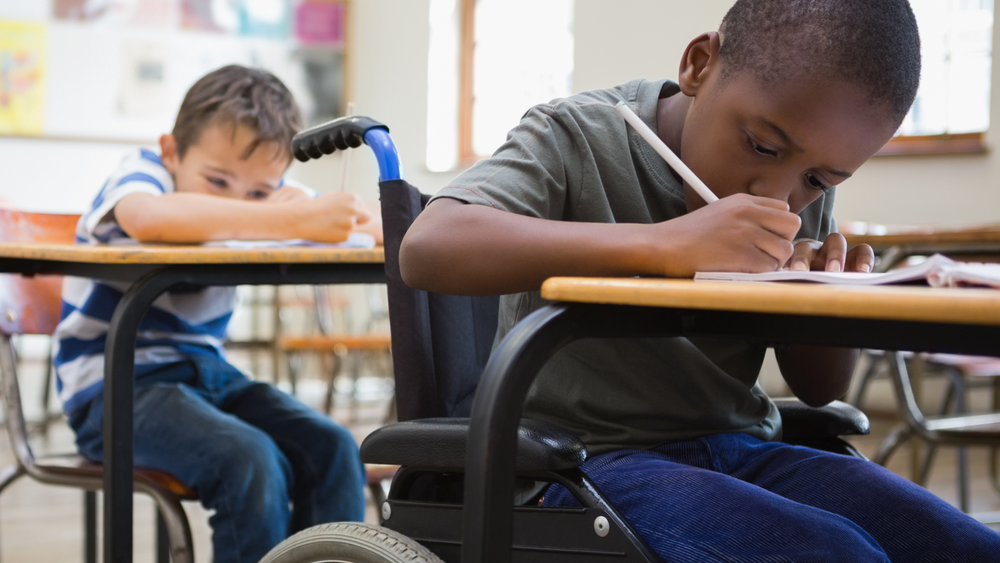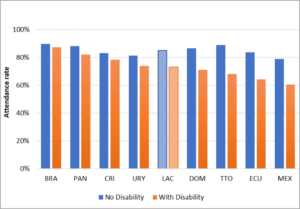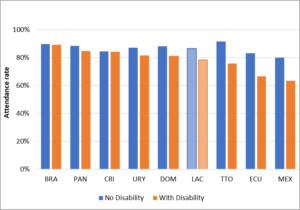The promise of inclusive education in Latin America and the Caribbean is still far from achieved, especially for the thousands of children and youth with some disability in the region. The probability of attending school for children between 6 to 11 years with disabilities is 8 percentage points lower compared to children without disabilities. And in high school, this gap only widens. The gap is greater in graduation rates than in attendance rates: Youth with disabilities have a lower probability of graduating from secondary compared to their peers, with a gap of 13 percentage points on average. More than half of youth with disabilities don’t finish secondary school!
In addition to the considerable share of children with disabilities who do not go to school, many who do attend are excluded from the teaching and learning processes, as they do not have adequate facilities, trained teachers, or reasonable adjustments that allow their full participation.
This means that despite the regulatory framework offered by the 2006 Convention on the Rights of Persons with Disabilities, which covers all countries in the region, and the efforts of many countries to improve opportunities for persons with disabilities, many children and young people with disabilities continue to experience exclusion.
A new IDB policy brief examines the status of inclusion in the educational systems of Latin America and the Caribbean. An analysis of census data for 8 countries shows that access to education varies according to disability status. The evidence shows a considerable gap in school attendance across disability status for children ages 6 to 11 years and youth ages 12 to 17 years. On average, children of elementary school age with disabilities are 8.5 percentage points (p.p.) less likely to be in school than their peers without disabilities. Moreover, for secondary schools ages of 12 to 17, this gap is even larger: an average of 10 percentage points. Across all 8 countries boys with disabilities are observed to have the lowest attendance rates of all demographic groups.
Additionally, comparing census data circa 2011 and household surveys circa 2017 we found that the gaps have not closed. The only country that shows strong signs of inclusion in secondary school is Chile, since it is the only country in which the gaps are less than 5 p.p. using a variety of measures.
Attendance Rate by Gender, Ages 12 to 17, censuses 2010-2011
Source: Hincapié, Duryea & Hincapié (2019). Note: In the case of the Latin American and Caribbean region, the average is calculated as the unweighted average of the national rates. |
All this indicates that, as a region, we still have much to improve in order to adequately address the needs of children and youth with disabilities in the school system.
An essential element is the training of inclusive teachers. Teachers must receive initial and in-service training to acquire the necessary skills in inclusive settings. It is not expected that all teachers can address the needs of all students on their own, but they must have the necessary skills to embrace diversity and promote an inclusive environment in the school.
Another key factor to achieve an inclusive education is to have a truly accessible school infrastructure. It is important to consider an accessibility that transcends mobility, including simple elements such as easy-to-use pencils, signage with easily recognizable symbols, screen readers, and other reasonable adjustments.
Of course, raising awareness and reducing stigma to prevent exclusion, violence, harassment and abuse are factors without which it will not be possible to achieve truly inclusive education.
A new IDB publication, We the People: Inclusion of People with Disabilities in Latin America and the Caribbean, offers a guide to promote economic and social inclusion of people with disabilities in the region. One of the biggest challenges in the region is the transition to inclusive schools that ensures the right to education of people with disabilities. Studies have found that students included in regular classes, in which they share a space and learn with their peers without disabilities, have better short and long-term academic results than students attending special schools (Hehir et al. 2016). But the transition to inclusive schools requires political will and commitment to provide a solid and coherent message from governments. It also implies taking into account the environment in which special education institutions operate, for example, redirecting knowledge, experience and resources curated by special education institutions to inclusive schools.
The promise of a truly inclusive education is still a distant dream in our region. It requires that everyone of us, as citizens, work to reduce stigma, bullying, and the exclusion of people with disabilities. What are you doing to achieve the inclusion of children and youth with disabilities in your country’s schools?




Leave a Reply